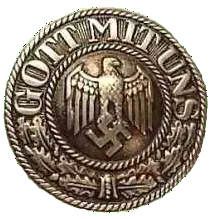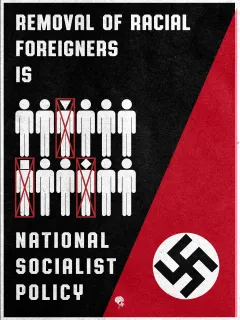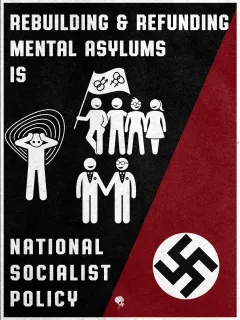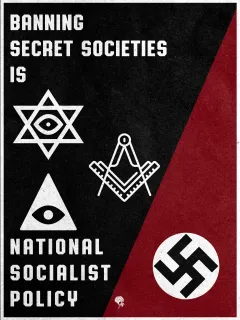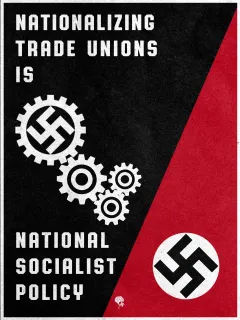https://www.youtube.com/watch?v=HsFamcBHdwA
Published on Apr 15, 2012
This version also has the original movie trailer at the beginning. The trailer is not translated to English, but the movie itself is captioned/translated into English.
Songs at the beginning and end of the movie were sung by Kirsten Heiberg, one of the stars of the movie and who was very popular in Germany during the war.
Titanic makes the allegory of the liner's loss specifically about British avarice rather than, as most Titanic retellings do, about general human arrogance and presumption. This fit in with other works of anti-British propaganda of the time such as My life for Ireland and Der Fuchs von Glenarvon; however, the scenes of British and French panic and desperation undermined this effect, while scenes of steerage passengers separated by crew members and desperately searching for their loved ones through locked gates and a chain link fence bore an uncanny resemblance to what was happening in German concentration camps during that time, contributing to its ban by Goebbels.
The film was shot on board the SS Cap Arcona, a passenger cruise ship which itself was sunk a few days before the end of World War II by the Royal Air Force on May 3, 1945, with loss of life far heavier than that on the actual Titanic. The scenes with the lifeboats were filmed on the Baltic Sea and some of the interior scenes were shot in Tobis Studios.
Titanic was the most expensive German production up until that time and endured many production difficulties, including a clash of egos, massive creative differences and general war-time frustrations. After one week of troubled shooting on the Cap Arcona, Herbert Selpin called a crisis meeting where he made unflattering comments about the Kriegsmarine officers, who were more concerned with molesting the female cast members rather than doing their job as marine consultants of the film. His close friend and co-writer of the script, Walter Zerlett-Olfenius, reported him to the Gestapo and Selpin was promptly arrested and personally questioned by Joseph Goebbels, who was the driving force behind the Titanic project. Within twenty-four hours of his arrest, Herbert Selpin was found hanged in his jail cell, which was ruled a suicide. The cast and crew were angry and attempted to retaliate, but were quickly silenced with fear for their own safety. The unfinished film, the production of which spiraled wildly out control, was in the end completed by Werner Klingler.
The premiere was supposed to be in early 1943, but the theatre that housed the answer print was bombed the night before the big event. The film went on to have a lacklustre premiere in Paris around Christmas of that same year, but in the end, Goebbels banned it altogether, stating that the German people, at that point going through almost nightly Allied bombing raids, were less than enthusiastic about seeing a film that portrayed mass death and panic.
Titanic was re-discovered in 1949, but was quickly banned in most western countries. After the fifties, the film went back into obscurity, sometimes showing on German television. But in 1992, a censored, low quality VHS copy, was released in Germany. This version deleted the strongest propaganda scenes, which immensely watered down its controversial content.
The issue of capitalism and the stock market plays a dominant role throughout the movie. The hero of the film is fictional German First Officer Herr Petersen (played by Hans Nielsen) on the ill-fated voyage of the British ocean liner RMS Titanic in 1912. He begs the ship's rich and snobbish owners to slow down the ship's speed, but they refuse and the Titanic hits an iceberg and sinks. The passengers in first class are shown to be sleazy cowards while Petersen, his lover Sigrid Olinsky (Sybille Schmitz), and other German passengers in steerage are shown as brave and kind. Peterson manages to rescue many passengers, convince Sigrid to get into a lifeboat (in a scene which was famously echoed in the 1997 film) and saves a young girl, who was obviously left to die in her cabin by an uncaring, callous British capitalist mother. The film ends with the British Inquiry into the disaster, where Peterson testifies against Bruce Ismay, condemning his actions, but Ismay is cleared of all charges and the blame is placed squarely on the deceased Captain Smith's shoulders. The epilogue states that "the deaths of 1,500 people remains un-atoned, forever a testament of Britain's endless quest for profit."
Directors:
Herbert Selpin, Werner Klingler
Screenplay:
Herbert Selpin, Walter Zerlett-Olfenius
Principal Cast:
Sybille Schmitz (Sigrid Olinsky),
Hans Nielsen (1st Officer Peterson),
Kirsten Heiberg (Gloria),
Ernst Fritz Furbringer (Sir Bruce Ismay),
Karl Schonbock (John Jacob Astor),
Charlotte Thiele (Lady Astor),
Otto Wernicke (Capt. Edward J. Smith)
1943, under the direction of the Reich Minister of Propaganda, Dr. Joseph Goebbels




